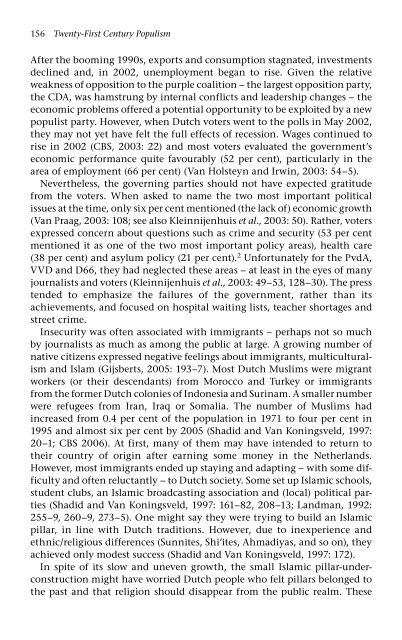Twenty-First Century Populism: The Spectre of Western European ...
Twenty-First Century Populism: The Spectre of Western European ...
Twenty-First Century Populism: The Spectre of Western European ...
Create successful ePaper yourself
Turn your PDF publications into a flip-book with our unique Google optimized e-Paper software.
156 <strong>Twenty</strong>-<strong>First</strong> <strong>Century</strong> <strong>Populism</strong><br />
After the booming 1990s, exports and consumption stagnated, investments<br />
declined and, in 2002, unemployment began to rise. Given the relative<br />
weakness <strong>of</strong> opposition to the purple coalition − the largest opposition party,<br />
the CDA, was hamstrung by internal conflicts and leadership changes − the<br />
economic problems <strong>of</strong>fered a potential opportunity to be exploited by a new<br />
populist party. However, when Dutch voters went to the polls in May 2002,<br />
they may not yet have felt the full effects <strong>of</strong> recession. Wages continued to<br />
rise in 2002 (CBS, 2003: 22) and most voters evaluated the government’s<br />
economic performance quite favourably (52 per cent), particularly in the<br />
area <strong>of</strong> employment (66 per cent) (Van Holsteyn and Irwin, 2003: 54−5).<br />
Nevertheless, the governing parties should not have expected gratitude<br />
from the voters. When asked to name the two most important political<br />
issues at the time, only six per cent mentioned (the lack <strong>of</strong>) economic growth<br />
(Van Praag, 2003: 108; see also Kleinnijenhuis et al., 2003: 50). Rather, voters<br />
expressed concern about questions such as crime and security (53 per cent<br />
mentioned it as one <strong>of</strong> the two most important policy areas), health care<br />
(38 per cent) and asylum policy (21 per cent). 2 Unfortunately for the PvdA,<br />
VVD and D66, they had neglected these areas − at least in the eyes <strong>of</strong> many<br />
journalists and voters (Kleinnijenhuis et al., 2003: 49−53, 128−30). <strong>The</strong> press<br />
tended to emphasize the failures <strong>of</strong> the government, rather than its<br />
achievements, and focused on hospital waiting lists, teacher shortages and<br />
street crime.<br />
Insecurity was <strong>of</strong>ten associated with immigrants − perhaps not so much<br />
by journalists as much as among the public at large. A growing number <strong>of</strong><br />
native citizens expressed negative feelings about immigrants, multiculturalism<br />
and Islam (Gijsberts, 2005: 193−7). Most Dutch Muslims were migrant<br />
workers (or their descendants) from Morocco and Turkey or immigrants<br />
from the former Dutch colonies <strong>of</strong> Indonesia and Surinam. A smaller number<br />
were refugees from Iran, Iraq or Somalia. <strong>The</strong> number <strong>of</strong> Muslims had<br />
increased from 0.4 per cent <strong>of</strong> the population in 1971 to four per cent in<br />
1995 and almost six per cent by 2005 (Shadid and Van Koningsveld, 1997:<br />
20−1; CBS 2006). At first, many <strong>of</strong> them may have intended to return to<br />
their country <strong>of</strong> origin after earning some money in the Netherlands.<br />
However, most immigrants ended up staying and adapting − with some difficulty<br />
and <strong>of</strong>ten reluctantly − to Dutch society. Some set up Islamic schools,<br />
student clubs, an Islamic broadcasting association and (local) political parties<br />
(Shadid and Van Koningsveld, 1997: 161−82, 208−13; Landman, 1992:<br />
255−9, 260−9, 273−5). One might say they were trying to build an Islamic<br />
pillar, in line with Dutch traditions. However, due to inexperience and<br />
ethnic/religious differences (Sunnites, Shi’ites, Ahmadiyas, and so on), they<br />
achieved only modest success (Shadid and Van Koningsveld, 1997: 172).<br />
In spite <strong>of</strong> its slow and uneven growth, the small Islamic pillar-underconstruction<br />
might have worried Dutch people who felt pillars belonged to<br />
the past and that religion should disappear from the public realm. <strong>The</strong>se



